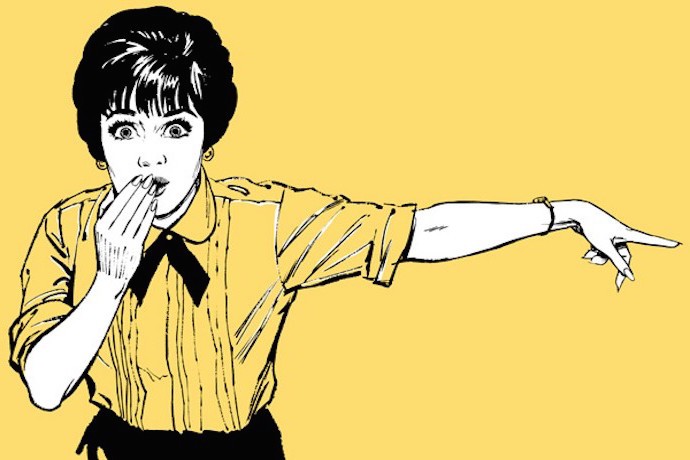For the past three weeks, The Cubit has explored blame in the twenty-first century. We approached scholars, scientists, policy experts, and theologians to ask how blame takes shape in the contemporary public square. If you haven’t been keeping up, you can read the introductory post or explore the full series.
We learned about killer robots, imaginary bathroom creepers, and the role of public housing policy in creating America’s Fergusons. We questioned our own hatred of Monsanto and made a mascot out of Megaman. Through this and more, we identified some maxims to help us do a better job at blaming.
So, the next time you’re searching for a scapegoat, motioning for a motive, feeling out a fall guy, or rooting around for a responsible party, consider using The Cubit’s Four Maxims for Better Blaming (patent pending). With these tips, you can avoid some common pitfalls that face blamers across the United States.
1. Know thyself
Blame doesn’t happen in a vacuum. It takes shape in the flesh of our brains, under the influence of some endowed psychological patterns. For example, Vlad Chituc’s interview with David Pizarro highlighted how blame distorts our judgments. Talking to Andrew Aghapour, psychologist Bertram Malle emphasized the specificity of blame as an evolved psychological process, which equips us to blame individuals and anthropomorphized entities, and makes it hard for us to blame faceless systems.
We all blame quickly, and sometimes sloppily. Getting to know our psychological tics can help us to blame better.
2. Beware of prejudices
 The past conditions the way we blame in the present. Numerous articles in the series grapple with racial prejudice, police brutality, and violent protests—topics that have been central to national conversations over the past year. Building on his interview with Richard Rothstein, Andrew Aghapour argues that we must learn to blame public institutions, like the federal government, for causing racial segregation and its resulting social dysfunctions. In her response Stephanie Gaskill writes that our individual prejudices still play a significant role in the plight of African Americans, since whites are more likely to blame crime on individuals if those individuals are black.
The past conditions the way we blame in the present. Numerous articles in the series grapple with racial prejudice, police brutality, and violent protests—topics that have been central to national conversations over the past year. Building on his interview with Richard Rothstein, Andrew Aghapour argues that we must learn to blame public institutions, like the federal government, for causing racial segregation and its resulting social dysfunctions. In her response Stephanie Gaskill writes that our individual prejudices still play a significant role in the plight of African Americans, since whites are more likely to blame crime on individuals if those individuals are black.
In his contribution, Haroon Moghul satirizes the tendency to blame specific incidents on the collective malice of the world’s 1.7 billion Muslims. Moghul flipped the script, giving Muslims credit for a laundry list of innovations, which helps to bring the absurdity of monolithic blaming into focus.
And Xarissa Holdaway looked at how racially-inflected blaming morphs into vengeance in the American prison system.
3. Beware of monsters
The landscape of blame is populated with monsters—big, lumbering, imaginary sources of evil that ultimately reflect our own fears.
In conversation with Andrew Aghapour, Megan Goodwin examines how new religious movements (NRMs) have become a locus of fears about sexual abuse. The cult captivity narrative is a monster that has escaped its origins and run amok, bolstering stereotypes about NRMs while diverting attention from other sites of sexual violence.
 Sarah Morice-Brubaker points out how the specter of fake-trans bathroom creepers has come to animate conservative Christian campaigns against sexual orientation non-discrimination ordinances; the “creepers” are imaginary, but the effects of the fear tactic are real.
Sarah Morice-Brubaker points out how the specter of fake-trans bathroom creepers has come to animate conservative Christian campaigns against sexual orientation non-discrimination ordinances; the “creepers” are imaginary, but the effects of the fear tactic are real.
And it isn’t just the political right that manufactures monsters. Alan Levinovitz highlights how the agricultural biotechnology firm Monsanto has become a Satanic figure for many liberals, to the point where it’s difficult for journalists to report on the company with any kind of balance.
Worried that blame monsters inhabit your head? Ask yourself a simple question: If someone said something positive about [person or group that I believe is a source of evil], would their statement immediately lead me believe they’re compromised? If the answer is yes, then you might want to examine your patterns of blame.
4. Blame is messy
Social events have multiple causes, and evil acts are no exception. As Hilary Ledwell argues in her analysis of a recent robot murder, even the consciousness-less can be difficult to blame. Just as with human defendants, we can direct blame upwards to an individual’s makers (parents or programmers), outwards to local conditions (social environments or the factory floor), or inwards to one’s internal programming. Robots should be simpler than us, and yet blaming them is just as difficult.
Despite this messiness, we are quick on the draw. Michael Schulson investigates why Western commentators rush to explain religious violence so quickly after an attack. Before the dust has settled, pundits and interest groups are quick to blame ideology, mental illness, or society for an attack—usually singling out one of those factors and ignoring the others. When an attacker shares one’s religion or political affiliation, there’s a tendency to blame mental illness; when an attacker comes from a political or religious group that someone detests, blame ideology instead.
After the next act of public violence, ask yourself: “Who, or what, am I immediately blaming? And why?”
Never netural
Blame is never quite neutral. Instead, it’s entangled with our fundamental conceptions of harm, justice, order, cause-and-effect. As such, blame plays on our deepest fears, as well as our impulses toward fairness. That doesn’t mean that we should stop assigning fault—just that we should always do so with a dose of caution.
Ultimately, we hope these guidelines will help you point fingers in a more measured and thoughtful way. Happy blaming!






